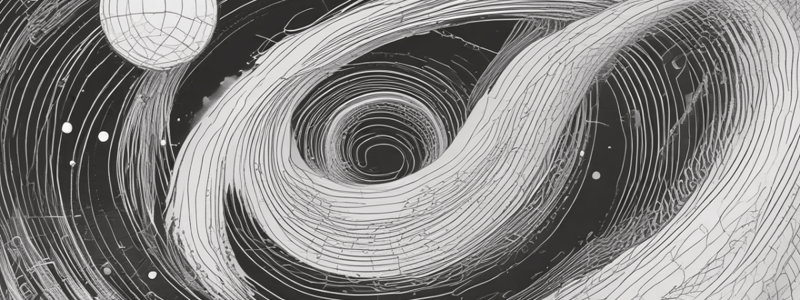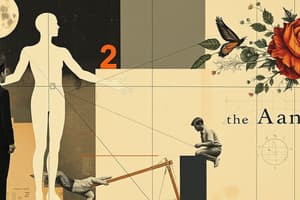Podcast
Questions and Answers
What happens to the book when someone pushes it from the left and it starts moving horizontally?
What happens to the book when someone pushes it from the left and it starts moving horizontally?
- The force of gravity and the normal force become unbalanced
- There are unbalanced forces at work (correct)
- The book starts moving vertically
- The book's state of motion remains the same
What type of forces are at work when the book is moved horizontally with a constant velocity?
What type of forces are at work when the book is moved horizontally with a constant velocity?
- Unbalanced forces
- Balanced forces (correct)
- Normal forces only
- Applied forces only
What happens to the book when the person stops pushing it?
What happens to the book when the person stops pushing it?
- It continues to move horizontally
- It returns to its state of rest (correct)
- It starts moving vertically
- It floats in mid-air
What is the state of motion of the book when it is traveling at a constant velocity?
What is the state of motion of the book when it is traveling at a constant velocity?
What happens when the book is pushed off the table?
What happens when the book is pushed off the table?
What is the state of motion of the book when it hits the floor?
What is the state of motion of the book when it hits the floor?
What type of forces are at work when the book is falling?
What type of forces are at work when the book is falling?
What is the state of motion of the book when it is at rest on the floor?
What is the state of motion of the book when it is at rest on the floor?
What is the minimum information required to describe a force?
What is the minimum information required to describe a force?
What does the size of the arrow in a vector diagram represent?
What does the size of the arrow in a vector diagram represent?
What is special about a free-body diagram?
What is special about a free-body diagram?
What is the purpose of a box in a free-body diagram?
What is the purpose of a box in a free-body diagram?
Why do we need to draw multiple forces in a free-body diagram?
Why do we need to draw multiple forces in a free-body diagram?
What can we infer about the forces acting on a book at rest on a table?
What can we infer about the forces acting on a book at rest on a table?
What is the relationship between the force of gravity and the normal force in the example of the book on a table?
What is the relationship between the force of gravity and the normal force in the example of the book on a table?
Flashcards are hidden until you start studying
Study Notes
Force and Vectors
- Force is a vector quantity, having both magnitude and direction, requiring specification of both for complete description (e.g., 5 Newton to the left).
- Vector diagrams represent vector quantities with arrows, where size indicates relative magnitude and direction indicates direction.
Free-Body Diagrams
- Free-body diagrams are a type of vector diagram, labeling each vector with the type of force and using a box to represent the object the forces act upon.
- Free-body diagrams can include any number of forces acting on an object.
Example: Book on a Table
- A book at rest on a table has balanced forces: gravity pulling down and normal force pushing up, equal in magnitude and opposite in direction.
- Adding a push from the left introduces unbalanced forces: applied force greater than friction, causing the book to move.
Unbalanced Forces
- Unbalanced forces cause a change in an object's state of motion.
- When the applied force stops, the book returns to rest, and the forces become balanced again.
Equilibrium
- Equilibrium occurs when horizontal forces are balanced, with no change in an object's state of motion (e.g., constant velocity).
- Free-body diagrams reflect equilibrium with equal-sized arrows in all directions.
Falling Book
- When the book is pushed off the table, vertical forces become unbalanced, and it falls due to gravity's greater magnitude.
- Air resistance opposes gravity, but gravity dominates, causing the book to hit the floor.
- Once on the floor, the book returns to rest, and the normal force balances with gravity, regaining equilibrium.
Studying That Suits You
Use AI to generate personalized quizzes and flashcards to suit your learning preferences.




